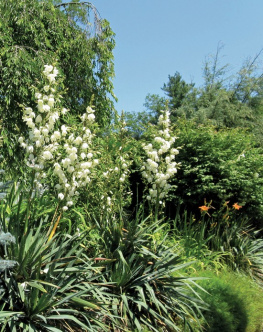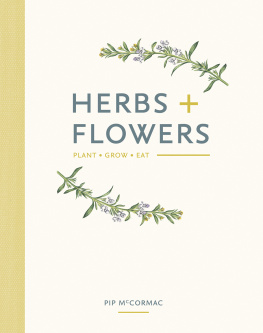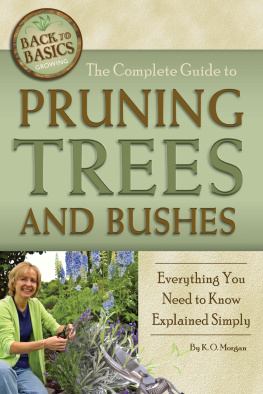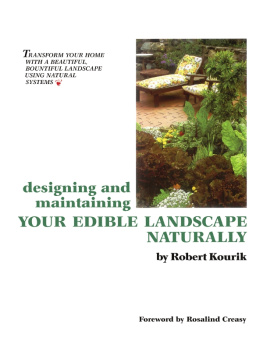Text 2010 Nan K. Chase
All rights reserved. No part of this book may be reproduced by any means whatsoever without written permission from the publisher, except brief portions quoted for purpose of review.
1. Plants, Edible. 2. Edible landscaping. I. Title.
Introduction
I love the fact that my yard feeds me. Its a lush and colorful landscape, but its also designed with eating in mind. In this edible landscape, theres usually something ripe; and when the weather grows cold, my cupboards and freezer are filled with the rest of the harvest.
The edible yard combines beauty and practicality: beautiful form in the garden with bounteous crops to eat fresh or preserve for year-round enjoyment.
Im not interested in ripping out the front lawn to plant zucchini and tomatoes. Sure, both those plants are useful to grow, but wheres the beauty? How does that summer-green tangle look in the dead of winter?
No, I propose a new way to visualize and plan a home garden, no matter the size. A way to use the garden more efficiently than ever, both to add definition, color, and texture to garden space and to maximize garden space for food production.
I want to give gardeners all over North America new ideas about the many beautiful trees, shrubs, vines, herbs, and wildflowers that also produce delicious fruits and other edible components (nuts, seeds, leaves, flowers, and tuberous roots).
This book contains more than thirty such plants or plant groupings, from apples to yucca, and I describe the most attractive design features of each: autumn leaf color, for instance, or winter interest, or spectacular flowers.
For each of these plants I also supply a recipe or twosomething mouthwatering, or something to put up for winter, or new ways to use familiar foods, or new foods to try for the first time.
In choosing the mix of recipes, I looked for opportunities to enjoy the foods at meals throughout the day, to use multiple plants in as many recipes as possible, and to preserve surplus in volume. All inspiration, I hope, for taking on the challenges of creating and utilizing an edible landscape.
My passion for growing edible plants in the landscape began long, long before the recent move toward locally grown food. My first encounters came more than fifty years ago, when I was still a toddler living in California. Our backyard was filled with fruit trees, and we kids took plums and almonds right off the branches as soon as we could climb up and get them.
Since then I have lived in Maryland and Wisconsin and have studied gardens in England, France, Hungary, and, most spectacularly, the former Yugoslavia; there, on the Adriatic Coast in 1990, my husband, Saul, and I stayed with a family whose small front yard was so densely packed with berry bushes, plum trees, and other edible plants that it fed an extended family of ten people. They lived in a small town, not on a farm, and yet they ate like royalty from a few square feet.
Is there any reason that the people living in our vast American suburbs, with their quarter-acre and half-acre lots, could not feed themselves, that we could not slash our countrys energy needs and food expenditures at the same time that we enhance our home landscapes?
For nearly the last thirty years I have lived and gardened in western North Carolina, and by now have tried, with varying degrees of success, to grow almost every plant listed in this book. Name it, I have it (except, currently, an olive, kumquat, almond, or pecan tree).
They havent all thrived, of course. Some trees never made it to year two, but others have produced steadily from the first season. By having a few specimens of lots of different edible landscape plants, my family has been able to enjoy a range of delicious, super-nutritious and organic foods from the yard: crabapple jelly and blueberry jam all winter, fresh greens in spring, grapes and apples and pears in summer, and soon, I hope, pawpaws in the fall. (Yes, I grow tomatoes and kale and squash, too, but they and the other kitchen crops of summer have their own low-profile territory in my yard.)
As for landscape beautytheres no question these edible plants are both functional and beautiful; the nut trees, the berry bushes, the herbs, the vines, and the wildflowers all add richness to the outdoor experience and to the views from indoors.
Mostly the edible landscape takes time, an investment of day-to-day attention, plus a willingness to drop everything else for a day or two when the harvest comes in. Should you be lucky enough to have a big crop, preserve as much as possible. Learn to can, dry, or freeze foods. Its not difficult. It just takes a commitmentthe choiceof time.
This book describes a relatively few edible landscape plants; the range of possibilities from around the world is too large to embrace in one volume of this size. I have selected the plants that I feel have the greatest landscape value for the greatest number of gardeners, and which have the greatest potential food enjoyment with a moderate amount of work.
I garden informally, having discovered that zones are meant to be stretched. Try taking advantage of microclimates in your own yardeven if its just a patio or balconyto expand your plant holdings. Most of the plants in this book grow in most of the country.
Good luck, and get started today!

Fruit blossoms like these delicate flowers are a feast for the eyes in early spring, but they must be tough enough to withstand rain and snow. Photo by Nan K. Chase.
A few words about organic gardening
For many gardeners there simply is no alternative to organic gardening, and I have grown almost all of my crops organically with great success and little bother. Even fruit trees, which sometimes require pest control, can be sprayed with organic compounds.
If you havent gardened before, or if you hope to improve the health of your garden (and your family), now is a good time to incorporate a few fundamental practices that can lessen dependence on harsh or dangerous chemical treatments.
The best way to nurture an organic garden is to invite birds into it. Install a birdbathnot a bird feederand keep it full. Plant lots of different flowering species. Birds need water, and once they arrive in your yard they will find plenty of food naturally. Birds will groom your plants, removing many insect pests as they feed and aerating the ground as they hunt for more.
Its also important to build and maintain healthy soil. With enough organic additives, even the hardest clay can be turned into rich, friable loam in a few years. When confronted with poor soil I have added lots of greensand (a natural soil conditioner), bone meal, blood meal, manure (or kelp meal or fish fertilizer), composted yard and kitchen waste, yet more greensand, and then topped it all with mulch.








